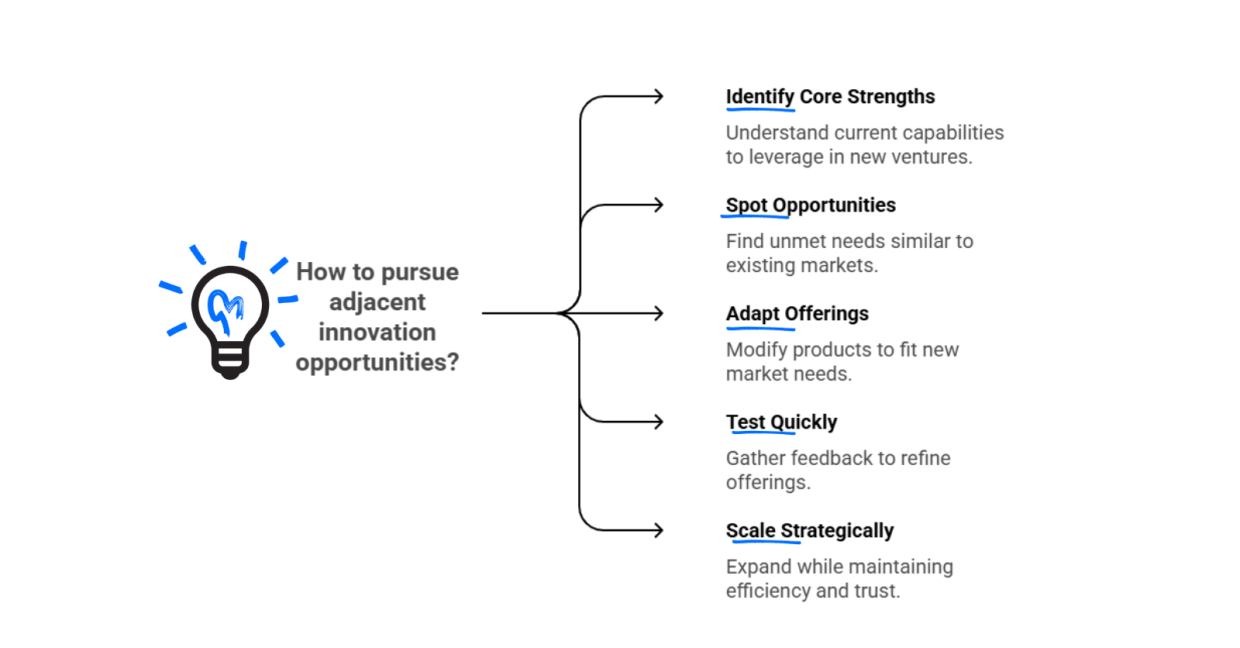Adjacent Innovation as a Growth Strategy
Tech Innovation
Adjacent innovation, the strategy of moving into closely related markets or services, is not a new concept. Yet in an increasingly competitive environment, it continues to offer companies a structured, lower-risk path to sustainable growth. By building on existing strengths, businesses can expand strategically while maintaining operational focus.
Understanding Adjacent Innovation
Adjacent innovation, as described in our Startup Terms Glossary, is the “expansion of a company’s core capabilities into a new but related market.” This involves leveraging existing products, services, expertise, or business models to move into new but related spaces. Companies explore customer needs that are similar to their core markets or develop new uses for their technologies. This approach lets them expand intelligently, without the high risks that come with launching into entirely unfamiliar territory. The idea is to stay close to your strengths while creating new revenue streams and growth opportunities.
Some of the world’s most successful companies have made adjacent innovation central to their growth strategies. Amazon began as an online bookstore but quickly expanded into selling a wide variety of products, all while using the same e-commerce and logistics infrastructure. Apple used its technology and design capabilities to move from personal computers into music players, smartphones, and wearables. Netflix evolved from DVD rentals to streaming video content, building on its expertise in delivering entertainment directly to consumers. Each of these companies took what they did best and expanded outward into adjacent markets, creating new paths to growth without abandoning their foundations.
Why Adjacent Innovation Matters
In a market where disruption happens fast and competition is fierce, adjacent innovation offers companies a way to evolve without taking extreme risks. It helps businesses stay relevant, deepen customer loyalty, and open new streams of revenue, all while building on what they already know.
Rather than betting everything on a moonshot idea, adjacent innovation provides a stepwise, manageable approach to expansion. Companies can quickly test new offerings, adapt them based on feedback, and scale them more efficiently because they are still operating within areas they understand.
Critical for Startups
For startups, adjacent innovation can be even more important. Resources are often tight. Time to market matters. Startups can’t afford to chase ideas that require a complete reinvention of their operations or brand. Adjacent innovation gives them a way to grow faster and smarter.
By identifying markets closely related to their initial product or customer base, startups can diversify earlier and create more resilience in their business models. They can enter new spaces while still leveraging their current capabilities, technology, and brand trust. This approach also makes startups more attractive to investors, who typically prefer companies that can show a credible, strategic path to growth without betting the company’s future on a single risky move.
Roadmap to Get Started
Implementing adjacent innovation starts with a clear understanding of what your startup already does well. The next step is identifying opportunities that lie close to that core. It might mean adapting your product for a slightly different customer segment, expanding into a related industry, or building a complementary service around your original offering.
Here’s a basic roadmap for startups thinking about adjacent innovation:
- Identify Core Strengths: Understand your current technology, market knowledge, and customer relationships.
- Spot Adjacent Opportunities: Look for customer needs or market gaps that are similar to the ones you already serve but are not fully addressed.
- Adapt Your Offerings: Make small but meaningful changes to your existing product or service to suit the new opportunity.
- Test Quickly: Launch a pilot, gather feedback, and refine your offering before a full rollout.
- Scale Strategically: Once validated, expand thoughtfully, keeping close to your core strengths to maintain operational efficiency and brand trust.

Adjacent Innovation in Action: Vee
A powerful example of adjacent innovation in action comes from Israeli startup Vee. Originally launched as a corporate volunteering platform, Vee connected employees with nonprofit opportunities around purpose-driven engagement. But as the company gained traction, the team recognized that the same technology powering its matching engine could address a much broader challenge: hiring.
Rather than abandon its core capabilities, Vee reimagined its infrastructure for a new use case. The company shifted its focus to become a talent acquisition platform, applying its matching algorithms to help companies find, evaluate, and connect with potential hires. The pivot expanded Vee’s addressable market significantly while staying rooted in the company’s existing technological strengths and mission-driven ethos.
This move exemplifies adjacent innovation: a strategic expansion into a neighboring market that leverages existing assets in a new way. For startups, especially in Israel’s agile tech ecosystem, it’s a reminder that transformation doesn’t always mean starting from scratch—sometimes it means reapplying what already works, just in a smarter context.
A Strategy for Sustainable Growth
Adjacent innovation offers a smart, practical growth strategy, especially for startups. It provides a way to expand customer bases, enter new markets, and increase resilience without straying too far from what makes a company strong in the first place.
In a world where change is constant and startups face pressure to scale quickly, adjacent innovation offers a balanced path forward: bold enough to fuel growth, strategic enough to manage risk.


 Tech Ecosystem
Tech Ecosystem Human Capital
Human Capital Focus Sector
Focus Sector The Health Network
The Health Network
 Business Opportunities
Business Opportunities Investment in Israel
Investment in Israel Innovation Diplomacy
Innovation Diplomacy Leadership Circle
Leadership Circle
